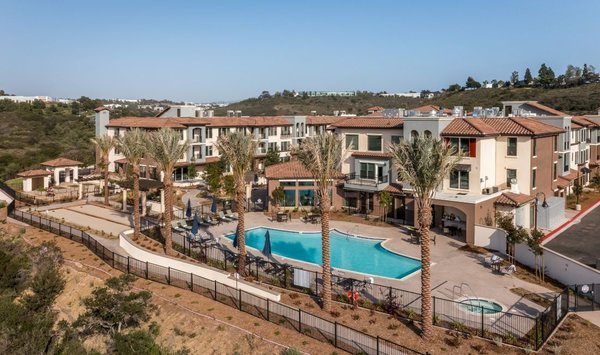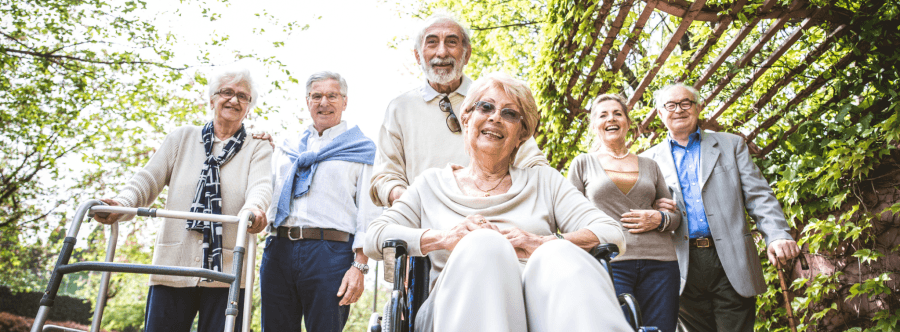Many seniors love how independent living communities reduce unwanted stress, hazards, and fatigue in their lives. Independent living communities take care of housekeeping, yard work and meals while still allowing residents personal space and the dignity of making their own choices. These communities usually provide seniors with an apartment that has a small kitchen, bathroom, living room, and one or more bedrooms. Those who want a small space may even find that some independent living communities offer studio-style apartments. Seniors can invite guests over and enjoy their rooms however they see fit.
Independent living communities often also include the following:
- Numerous opportunities for socializing and exploring new activities
- Easy access to public or community-provided transportation
- Meal plans for community dining as well as kitchens for seniors who like preparing their own meals
- The ability to keep small- and medium-size pets such as dogs and cats
- Housekeeping, laundry and groundskeeping services
- 24-hour staff on-site who can be contacted if a problem arises
For a more detailed look at common amenities, check out our guide to independent living communities.
What Couples Should Know About Independent Living in San Diego, CA
San Diego is an idyllic seaside community of 1.4 million people, where average summer temperatures stay around 76 degrees and breezy sunshine is the norm. Seniors in San Diego pay an average of 15% less for medical care at excellent local facilities, such as UC San Diego Health. Crime rates are 20% lower in San Diego than the national average, which along with the weather and the thriving senior community, encourages aging citizens to get outdoors and meet others at senior-friendly local events, such as Forever Fit in Lopez Ridge park.
Senior couples can get around San Diego at a discount by riding the buses and light rail of San Diego Mass Transit (SDMT). SDMT buses are all disabled-ride equipped, and routes cover almost all of the busiest parts of the city out to the quiet suburbs.
Paying for Independent Living in San Diego, CA
San Diego seniors pay an average of $3,720 a month for independent living. This is significantly higher than the national average monthly cost of $2,550. Seniors in some nearby areas, such as National City, also pay somewhat less than San Diego’s average cost, at $3,360.
The annual cost of living in an independent living community can range anywhere from $12,000-$42,000, depending mostly on the amenities, room type and cost of living in the area. In addition to using personal retirement income, annuities, long-term care insurance, or cashing out an existing life insurance policy, some seniors can use Social Security funds, Supplemental Security Income (SSI) payments granted due to disability or low-income or HUD-provided housing assistance such as vouchers. Another route many seniors choose to fund their independent living stay is renting out or selling their homes that they won’t need once they move or taking advantage of a reverse mortgage.
Our guide provides a more in-depth look at independent living costs and solutions for those who want to learn more.
How to Choose an Independent Living Community
When choosing an independent living community, it’s best to consider many factors, including the community’s proximity to loved ones and medical care, the state of repair that the facility appears to be in, the attitude and efficiency of the staff, the cost of both rent and services, the facility’s pet policy and more.
Comparing multiple communities can help seniors and their families figure out what they value most in an independent living community. During tours of these communities, staff members should be available to answer questions. To help with the touring and comparison process, we’ve included a checklist full of pertinent questions that anyone can download and print for themselves.
Transitioning to Independent Living
Independent living communities, rather than memory care or nursing homes, are often the first place seniors move to when they realize they need a lifestyle change. The necessity of letting some possessions go and the reality of leaving a home and neighborhood after possibly decades of residence there can make transitioning to an independent living community difficult. These communities are often friendly places, but being in a new environment still initially triggers feelings of loneliness in many seniors.
Having a strategy for dealing with the challenges of moving can make the transition to an independent living community a positive experience. We’ve created a downloadable step-by-step guide for tips to making this transition as smooth and enjoyable as possible.
























